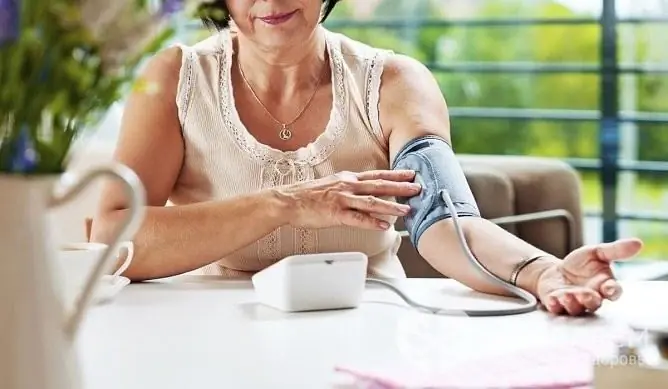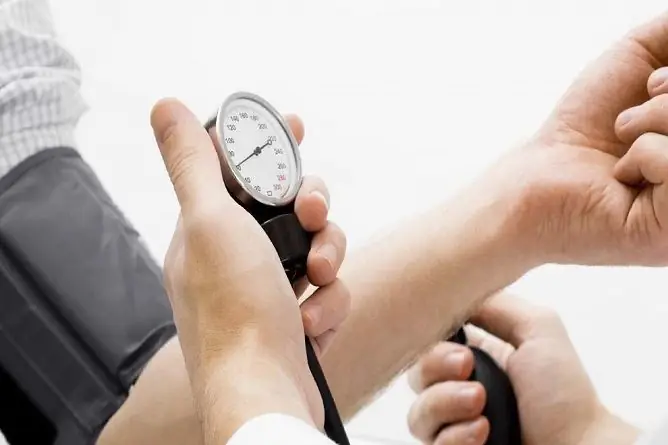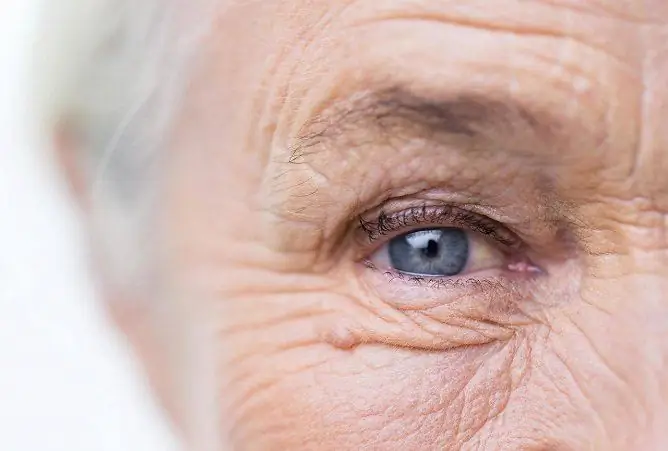- Author Rachel Wainwright [email protected].
- Public 2024-01-15 19:51.
- Last modified 2025-11-02 20:14.
The rate of pressure of a person by age
The content of the article:
- Blood pressure and pulse
- Reasons for the difference in human pressure norms by age
- Blood pressure rate by age
- Patterns of BP change at different ages
- Pressure measurement rules
- Video
The pressure rate at any age should not exceed 140/90 mm Hg. Art., despite the fact that the indicators of the functioning of the cardiovascular system in both men and women dynamically change throughout life.
Each age group has specific indicators. They depend on the anatomical features of the bloodstream, the level of physical activity, the presence or absence of concomitant pathologies, hormonal levels at each stage of life. Also, blood pressure (BP) readings will vary depending on gender. In this case, the upper blood pressure is in the range from 100-110 to 139 mm Hg. Art., and the lower - 70-89.

Currently, WHO has clearly established the pressure limits - it should not exceed 139/89 mm Hg. Art.
Blood pressure and pulse
BP is understood as a value that determines the intensity of the effect of blood flowing through the arteries from the inside on the vascular wall. The readings are recorded in millimeters of mercury, or mercury column. International designation - mm Hg (mm Hg. Art.).
Blood pressure is not an isolated indicator. Its relationship with the heart rate is determined. Under normal conditions, when internal regulation is adequately carried out, with an increase in blood pressure, the heart rate decreases. And vice versa - at low pressure to maintain adequate blood supply to all organs and tissues, the heart begins to work more actively, the heart rate (HR) increases.
If the regulatory mechanisms break down, blood pressure abnormally decreases or increases. In the first case, hypo-, and in the second, hypertension develops.
Reasons for the difference in human pressure norms by age
In the process of life, the circulatory system undergoes a number of structural and functional changes. This is facilitated by acquired chronic diseases, acute pathological conditions, a certain stereotype of nutrition, exposure to harmful factors, lifestyle, etc.
Under the influence of external and internal reasons, the following transformations occur in the heart and blood vessels throughout life:
- changes (usually in the direction of decreasing) the frequency of heart contractions;
- accumulates cholesterol deposits on the walls of blood vessels;
- the contractile ability of the heart muscle is limited;
- gas exchange becomes less active;
- the minute and stroke volumes of the heart decrease;
- the area of the capillary bed and the total arterial section is reduced;
- atherosclerotic changes in the vascular walls are increasing;
- increased vascular resistance to blood flow in the periphery.
Thus, upon reaching old and senile age, changes in the bloodstream accumulate, naturally provoking an increase in blood pressure. However, blood pressure numbers do not usually rise all over the place. This is due to the age-related decrease in the activity of the pumping function of the heart.
Blood pressure rate by age
Several years ago, it was believed that blood pressure standards are legitimate only for young or middle-aged people. At the same time, it was noted that in the elderly or elderly patients (75-80 years old and older), the systolic pressure figures can reach 140-150 mm Hg. Art. This was not considered a pathology and was explained by the structural rearrangement of the vascular bed and changes in the activity of the heart.
Currently, the World Health Organization unambiguously sets an upper threshold for all people of all ages: systolic pressure should not exceed 139 mm Hg. Art., diastolic - no more than 89.
Table of pressure norms by age in an adult patient
| Age | The value of blood pressure, mm Hg Art. |
| up to 25 years | 115-123 / 72-75 |
| up to 30 years | 120-125 / 75-79 |
| 30-35 years old | 127-128 / 80-81 |
| under 40 | 129-130 / 82-83 |
| under 50 | 130-135 / 83-84 |
| up to 60 years | 135-139 / 84-85 |
| 60 and older | 135-139 / 84-89 |
The value of pressure in women from men normally differs slightly, no more than a few millimeters of mercury. However, males are more likely to increase blood pressure between the ages of 35-38 and 55-58. In women, an increase in systolic blood pressure numbers is more often observed after 65 years.
Patterns of BP change at different ages
In children under one year old, blood pressure is very low compared to the parameters of an adult. Standard blood pressure figures are established around adolescence.
If the child has a large weight and height compared to peers, he may have higher blood pressure.
Girls have lower blood pressure than boys. From 15-17 years old, the opposite phenomenon begins to be observed.
In children, just as in adults, there may be abrupt increases in indicators: during sucking in infants, with excitement, fear, stress. If the child is healthy, the numbers stabilize in 3-4 minutes after the elimination of the provoking factor.
Blood pressure gradually increases throughout life, and upon reaching old age the process accelerates.
In elderly patients, the normalization of the pressure value after its rise occurs more slowly than in young patients.
Pressure measurement rules
To reliably find out what normal pressure is typical for a particular patient, it is necessary to correctly measure it.

To get a reliable result, you must measure the pressure correctly
The algorithm for determining blood pressure includes several specific actions in a specific sequence:
- Take a comfortable position so as not to experience discomfort during the procedure. For half an hour before the study, refrain from taking stimulants, tonic drinks, excessive physical activity.
- Prepare a tonometer. At the mechanical apparatus, assess the condition of the pressure gauge and pear, connecting tubes, cuff. Open the valve on the supercharger and empty the cuff as much as possible of the air by rolling it into a tube. At the electronic device, press the power button, check the performance of the power supply (batteries).
- Place the hand on which the measurement will be made on a flat surface, approximately at the height of the middle of the chest.
- Put on the cuff, fixing it in accordance with the instructions for the device. Excessively tight or excessively loose overlap should be avoided: the index finger should fit freely between the skin and the inner surface of the patch.
- With a mechanical device, place the phonendoscope head on the skin of the elbow bend in the place of the most distinct pulsation of the artery. Close the blower valve and inflate the cuff. Press the "Start" button at the electronic device.
- Measure and evaluate the result.
When determining the pressure with a hand-held apparatus while bleeding air from the cuff, it is necessary to listen through the phonendoscope to the emerging Korotkov tones. The noises must be correlated with the BP numbers on the dial of the manometer. The beginning of the pulsation will correspond to the value of the systolic pressure, its end will correspond to the value of the diastolic pressure.
The electronic device measures, interprets the obtained data and demonstrates the result independently, without user intervention.
Video
We offer for viewing a video on the topic of the article.

Olesya Smolnyakova Therapy, clinical pharmacology and pharmacotherapy About the author
Education: higher, 2004 (GOU VPO "Kursk State Medical University"), specialty "General Medicine", qualification "Doctor". 2008-2012 - Postgraduate student of the Department of Clinical Pharmacology, KSMU, Candidate of Medical Sciences (2013, specialty "Pharmacology, Clinical Pharmacology"). 2014-2015 - professional retraining, specialty "Management in education", FSBEI HPE "KSU".
Found a mistake in the text? Select it and press Ctrl + Enter.






